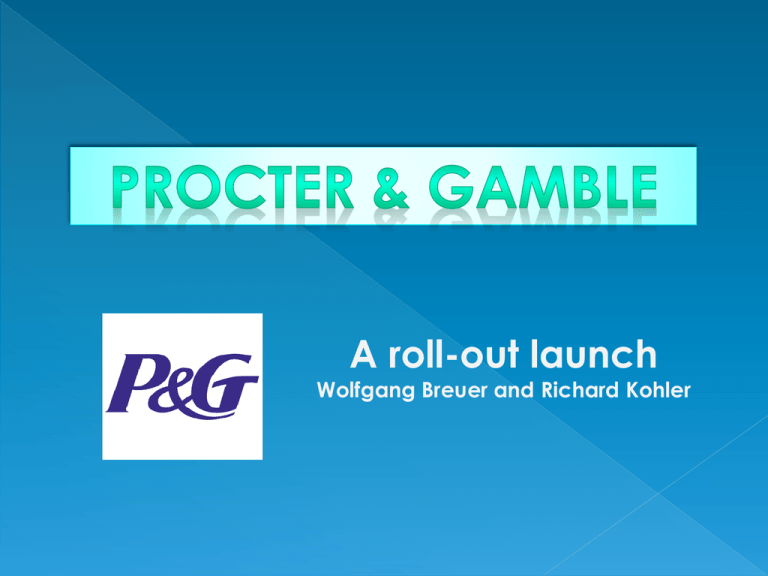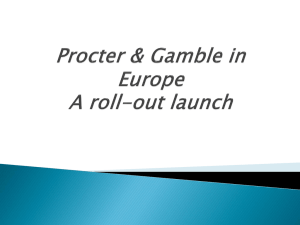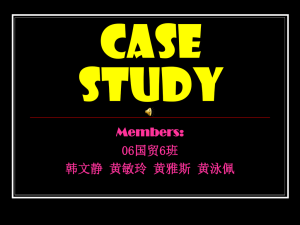A roll-out launch Wolfgang Breuer and Richard Kohler
advertisement

A roll-out launch Wolfgang Breuer and Richard Kohler Should BC-18 product be based on pan European product or through adoption of more than one brand name to reflect local market needs. Competitors have increasingly been imitating P&G’s innovative products and marketing strategy. P&G was founded in the US in 1837. Today, it is the world’s biggest manufacturer of packaged consumer goods. Global leader in health and beauty products, detergents, diapers and food. (Pampers, Ariel, Mr. Proper, Camay etc.) P&G’s profit is generated by its international operations which is the fastest growing part of the business. P&G bought in 1985 the Richardson-Vicks Co. (with brands like Head and Shoulders, Vidal Sassoon, Pantene) In 1987, the Blendax Group (dental care and beauty products) Billion dollar brands Ariel is a brand of laundry detergent/liquid available in numerous forms and scents. Bounty is a brand of paper towel sold in the United States and Canada. Braun is a small-appliances manufacturer specializing in electric shavers, epilators, hair care appliances and blenders. CoverGirl is a brand of women's cosmetics. Crest/Oral B is a brand of toothpaste and teeth whitening products. Dawn/Fairy is a brand of dishwashing detergent.[16] Downy/Lenor is a brand of fabric softener. Duracell is a brand of batteries and flashlights. Fusion is a brand of men's wet shave razors and is the quickest P&G brand to have reached $1 billion in annual sales. Gain is a brand of laundry detergent, fabric softeners and liquid dish soap. Gillette is a brand of safety razor and male grooming products. Head & Shoulders is a brand of anti-dandruff shampoo and conditioners. Olay is a brand of women's skin care products. Oral-B is a brand of toothbrush, and oral care products. Pampers is a brand of disposable diaper and other baby care products. Pantene is a brand of hair care products (conditioners/styling aids). Pringles is a brand of potato chips. Ace/Tide is a brand of laundry detergent. Wella is a brand name of hair care products (shampoo, conditioner, styling, and hair color). Always/Whisper is a brand of pantyliners sold primarily in Asian markets. Flash/Mister Clean is a brand of multi-purpose cleaner, and spray sold in the United States and Great Britain. Basic principles of P&G: “superior total value” and should meet basic consumer needs” This resulted in a strong commitment to research to create products that are demonstrably better than others. They believe that through continual product development, brands could remain healthy and profitable in the long-term. Group of three or four people, assumes general responsibility for its brand. Plan develop business objectives, strategies and marketing plans. Selects advertising and media, develop sales promotion, manages package design and product improvement projects and initiates cost savings. The haircare market- made up of sub- markets Relevant market for BC-18 -> SHAMPOO AND CONDITIONERS 1985 use per head shampoos- 400 (SU 1000) 1985 use per head conditioners-180 (SU 1000) Shampoo market highly fragmented Introduction BC-18 technology in 1986 Brand Pert-> brand Pert Plus P&G key brands (Vidal sasson, Pert, Pert Plus, Ivory, Head&Shoulders Competitor brands (Suave, Flex) Long term marketing goal for BC-18market share of at least 10% by the end of 1989/90 POSITIONING: provide great looking hear in convenient way TARGET GROUP: all people SOURCE OF BUSINESS: new users PRICE: US $3.20 for the 15 oz size Strong TV advertising- in first year, from March to December Steady growth of shampoo and conditioner market (increased hair washing) Conditioner+shampoo user below the 44% in USA Focus on: West Germany, Great Britain, France, Scandinavia and Benelux. Important competitors: Unilever, Colgate and L’oreal Big gap between the top and bottom price Value based market share was very important To send the brand message, media suport was a key driving force The cost structure of the existing P&G shampoo brands. P&G face to some restrictions: The available production capacity: capacity of the 1st year: 2000 MSU 2nd year: 4000 MSU 3rd year: 8000 MSU But: with 6 months’ notice it have been possible extra 500 MSU capacity Lead times The development of a new 200ml bottle takes a lead time of 12 months The lead time of developing new 250ml bottle will take 6 months Would you undertake a “roll-out” launch, and if so in what country order? What are the decision criteria for this order? In answering this question you should take into account the expected sales volumes as well as the given capacity restriction. Taking the country with the highest priority, which principles would you use in order to budget media spending? Set out a rough media plan for the first twelve months, with proposals for pomotion activities in the first year. How should media and promotion activities be budgeted for the following years? European markets with background voiceovers changing according to language of the country, elements can be changed through the means of air-brush computer software e.g. the background. This will allow the company to cut down on promotional costs SECOND YEAR To maintain the growth of market share. Sampling will go down, but should be raised again for the new marketing cycle when decline begins. . . . TV advertising can be reduced when the product reaches its mature stage. In the third year, all countries will make profits and the company will break even point. Examine the cost and revenue implications of the Europe-wide introduction programme. Is there any loss to be expected in the first years? Does this require a modification of the order of local market entries? In the table profit, there are any loss in the first year, for West Germany, Great Britain, and Scandinavia. Those happened because in the first year, they spend many for media and promotion cost. Great Britain and Germany are already profitable after the first year but with the introduction in the other countries in the second year, the gain in Great Britain and Germany will not compensate the losses of the first year and the losses due to the introduction in those countries. What are the main issues to be considered in balancing a pan-European introduction strategy with local market needs? For example, what are the possible alternative brand name strategies? Should BC-18 technology be introduced with a pan-european name,or with local brand names, or even with a mixture of both approaches? Should a new brand be created, or should an existing brand relaunched in a new quality? What are possible criteria for that decision? What is longer-term marketing objective? What are the alternative possibilities in relation to issues of positioning, target groups, sources of business, pricing strategy and packaging? As we see, the BC-18 technology should be introduced with a mixture of both approaches—with a pan-European name and local brand names. If we just introduce with a pan-European name is bad for the promotion of the BC-18. Local names sound approachable. People are likely to accept them. But if we just use local names we will have some problems in selling them in the whole Euro. So the best way is using both of them. BC-18 technology would offer the European consumers 'Great looking hair in a convenient way'. Currently P&G are practicing a strategy called "Euro-Balancing" , it entails the concept of standardizing to the maximum and implementing localization only where necessary. By introducing a single brand name for its potential market, P&G does not have to create new marketing campaigns for targeted countries. The European market is heterogeneous, multicultural and multilingual; therefore, the name chosen for the shampoo should have to no connotations in a particular language's history or religion. Moreover, the name should be easily pronounceable in each culture. Longer term marketing objectives P&G is to become a leader in the European market of two in one hair products. In Europe a steady growth of the shampoo market and the conditioner market could also be seen. Positioning : combination of shampoo and conditioner in one that is easy, time saving, and everyday usage Target group : everyone Source of business : all users Pricing : premium-priced segment; this is done in order to keep up the image of the shampoo as a high quality and innovative product. Packaging : 200ml or 250 ml bottle How do you specify the first-year marketing objective? How does this relate to the longer-term marketing objective? The first year marketing objective is to attract new European customers from competing brands to shift to the use of shampoo to BC-18. The aim is to exert a pull on the population in order to create a new market niche inside the shampoo market and encourage the people to use the new BC-18. In effect BC-18 technology serves the core need of washing hair and therefore it has to compete with the different national brands which are often well established. P&G is an international supplier of consumer goods it is a "global leader in health and beauty care products, detergents, diapers and food. P&G's presence in the hair care market in the U.S has been strengthened by innovative technology BC-18 and the replacement of an old brand 'Pert' with 'Pert Plus'- a mild shampoo with a fully effective conditioner. P&G decided to introduce BC18 in Europe. Traditionally, the European market is highly competitive the main rivals are Colgate, Unilever, and L'oreal. The European market is segmented (i.e. value based) and sensitive to price changes (i.e. elastic demand).The introduction of the new product BC-18 brings with it a new marketing strategy for the company. In order to make a valued choice the 4P's of marketing have to be considered. Research indicates in Europe there are large price differences among hair care products. P&G has decided that it should place the new shampoo in the premiumpriced segment; this is done in order to keep up the image of the shampoo as a high quality and innovative product. P&G should charge premium price in each country to be sold for 4.99 DM for the 200 ml bottle and for 5.99 DM for the 250 ml bottle in all the countries which had had been accepted during the consumer tests. The company cannot charge a price very few people can afford, this will also not be profitable for the company.



